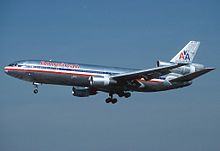McDonnell Douglas DC-10
The DC-10-30 and –40 models (with a third main landing gear leg to support higher weights) each had intercontinental ranges of up to 5,200 nmi (9,600 km; 6,000 mi).Early operations of the DC-10 were afflicted by its poor safety record, which was partially attributable to a design flaw in the original cargo doors that caused multiple incidents, including fatalities.In August 1983, McDonnell Douglas announced that production would end due to a lack of orders, as it had widespread public apprehension after the 1979 crash and a poor fuel economy reputation.[2] As design flaws were rectified and fleet hours increased, the DC-10 achieved a long-term safety record comparable to those of similar-era passenger jets.After merging with McDonnell Douglas in 1997, Boeing upgraded many in-service DC-10s as the MD-10 with a glass cockpit that eliminated the need for a flight engineer.The aviation author John H. Fielder notes that the company was under competitive pressure to produce a wide-body aircraft, having been somewhat slow in the previous decade to introduce its first jetliners.[7][8] An early DC-10 design proposal was for a four-engine double-deck wide-body jet airliner with a maximum seating capacity of 550 passengers and similar in length to a DC-8.The proposal was shelved in favor of a trijet single-deck wide-body airliner with a maximum seating capacity of 399 passengers, and similar in length to the DC-8 Super 60.According to Fielder, McDonnell Douglas had been urgently pursuing the DC-10's completion in light of the prospective competition and the high financial stakes involved.[15][16][17] The DC-10's similarity to the Lockheed L-1011 in design, passenger capacity, and launch date resulted in a sales competition that affected the profitability of both aircraft.Fielder alleges that McDonnell Douglas consistently sought to minimize and postpone any design changes to the DC-10, although this attitude was not an explicit policy.[22] In July 1971, Convair outlined the situation in a formal memo; almost a year later, it internally expressed concerns that the inadequate resolution would lead to loss of aircraft.[39][40] In the late 1980s, international travel was on the rise due to lower oil prices and more economic freedom, leading to a surge in demand for wide-body airliners.It is sized to conduct medium to long-range flights, offering similar endurance to the larger Boeing 747 yet being able to use shorter runways and thus access airports that it could not.To enable higher gross weights, the later –30 and –40 series have an additional two-wheel main landing gear, which retracts into the center of the fuselage.[45] The critical nature of these circuits and their vulnerability to damage in the tail area led to the addition of hydraulic fuses to prevent the total loss of fluid.[55] A proposed version of the DC-10-10 with extra fuel tanks, 3 feet (91 cm) extensions on each wingtip, and a rear center landing gear.McDonnell Douglas held a major presentation of the proposed DC-10 Twin at Long Beach, and several European airlines were willing to place orders.Later, more DC-10 Twin proposals were made, either as a collaboration with a European manufacturer or as a solely McDonnell Douglas product, but none proceeded beyond design studies.When the aircraft reached approximately 11,750 feet (3,580 m) in altitude, the door blew out, and the resulting explosive decompression collapsed the cabin floor.[100] Investigators found that the DC-10's relief vents were not large enough to equalize the pressure between the passenger and cargo compartments during explosive decompression.[109] Following this crash, a special subcommittee of the United States House of Representatives investigated the cargo-door issue and the certification by the Federal Aviation Administration (FAA) of the original design.[111] Its left engine and pylon assembly swung upward over the top of the wing, severing the leading edge slat actuator hydraulic lines.This, combined with asymmetric thrust due to the missing engine, caused the aircraft to rapidly roll to the left, descend, and crash, killing all 271 people on board and two on the ground.[113][114] These measures were rescinded five weeks later on July 13, 1979, after the slat actuation and position systems were modified, along with stall warning and power supply changes.












DC10 (disambiguation)McDonnell Douglas DC-XVickers VC10Continental AirlinesWide-bodyairlinerManufacturerMcDonnell DouglasFedEx ExpressAmerican AirlinesUnited AirlinesNorthwest AirlinesMcDonnell Douglas KC-10 ExtenderDC-10 Air TankerMcDonnell Douglas MD-11trijetwide-body aircraftturbofansvertical stabilizernautical-miletranscontinental flightshot and highKC-10 Extendertanker aircraftUnited States Air ForceTurkish Airlines Flight 981American Airlines Flight 191Federal Aviation Administrationfuel economyLockheed L-1011 TriStarBoeingglass cockpitflight engineerCargo airlinesfreightersFlying Eye Hospitaleye surgeryaerial firefightingstorageCX-HLS (Heavy Logistics System)Douglas AircraftjetlinersBoeing 747McDonnell Aircraft CorporationStapleton International AirportsubcontractedConvairLockheed L-1011LockheedGeorge A. SpaterJames S. McDonnellRolls-Royce RB211maiden flighttype certificatePratt & Whitney JT9DGeneral Electric CF6Airbus A300Long Beach, CaliforniaNigeria Airwaysoil priceseconomic freedomBoeing 747-400Airbus A330Boeing 777Boeing 747-100baggageturbofanthrust reversersBoeing 727aileronselevatorsrudderleading edge slatsspoilershorizontal stabilizertricycle landing gearautopilotCassette tapeshydraulichydraulic fusesGE CF6slanding gearsGE CF6-6MexicanaAeroméxicoSwissairOverseas National AirwaysTrans International AirlinesFinnairAlitaliaPratt & Whitney JT9DsNorthwest Orient Airlinesfleet commonalityJapan Airlineslanding gearLockheed L-1011-500Airbusaerial tankeraerial refuelingRoyal Netherlands Air ForceOmega Aerial Refueling ServicesErickson Air-CraneBoeing 717type ratingList of McDonnell Douglas DC-10 operatorsTransportes Aéreos BolivianosMiami International AirportCadillac FleetwoodBiman Bangladesh AirlinesBirminghamTAB AirlinesBoliviancargo airlineCargo Three10 Tanker Air CarrierOrbis InternationalMissile Defense Agencyaccidents and incidentshull-losshijackingsbombingAmerican Airlines Flight 96pressurizationexplosive decompressionWindsor, Ontarioempennage